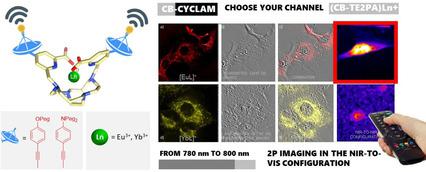当前位置:
X-MOL 学术
›
ChemPhysChem
›
论文详情
Our official English website, www.x-mol.net, welcomes your
feedback! (Note: you will need to create a separate account there.)
Cationic Biphotonic Lanthanide Luminescent Bioprobes Based on Functionalized Cross-Bridged Cyclam Macrocycles.
ChemPhysChem ( IF 2.3 ) Pub Date : 2020-04-07 , DOI: 10.1002/cphc.202000085 Jonathan Mendy 1 , Anh Thy Bui 2 , Amandine Roux 2 , Jean-Christophe Mulatier 2 , Damien Curton 2 , Alain Duperray 3 , Alexei Grichine 3 , Yannick Guyot 4 , Sophie Brasselet 5 , François Riobé 2 , Chantal Andraud 2 , Boris Le Guennic 6 , Véronique Patinec 1 , Pr Raphael Tripier 1 , Maryline Beyler 1 , Olivier Maury 2
ChemPhysChem ( IF 2.3 ) Pub Date : 2020-04-07 , DOI: 10.1002/cphc.202000085 Jonathan Mendy 1 , Anh Thy Bui 2 , Amandine Roux 2 , Jean-Christophe Mulatier 2 , Damien Curton 2 , Alain Duperray 3 , Alexei Grichine 3 , Yannick Guyot 4 , Sophie Brasselet 5 , François Riobé 2 , Chantal Andraud 2 , Boris Le Guennic 6 , Véronique Patinec 1 , Pr Raphael Tripier 1 , Maryline Beyler 1 , Olivier Maury 2
Affiliation

|
Cationic lanthanide complexes are generally able to spontaneously internalize into living cells. Following our previous works based on a diMe‐cyclen framework, a second generation of cationic water‐soluble lanthanide complexes based on a constrained cross‐bridged cyclam macrocycle functionalized with donor‐π‐conjugated picolinate antennas was prepared with europium(III) and ytterbium(III). Their spectroscopic properties were thoroughly investigated in various solvents and rationalized with the help of DFT calculations. A significant improvement was observed in the case of the Eu3+ complex, while the Yb3+ analogue conserved photophysical properties in aqueous solvent. Two‐photon (2P) microscopy imaging experiments on living T24 human cancer cells confirmed the spontaneous internalization of the probes and images with good signal‐to‐noise ratio were obtained in the classic NIR‐to‐visible configuration with the Eu3+ luminescent bioprobe and in the NIR‐to‐NIR with the Yb3+ one.
中文翻译:

基于功能化跨桥Cyclam大环的阳离子双光子镧系元素发光生物探针。
阳离子镧系元素络合物通常能够自发内在化进入活细胞。根据我们先前基于diMe-cycln框架的工作,使用was(III)和y( III)。在各种溶剂中对它们的光谱性质进行了彻底研究,并借助DFT计算对其进行了合理化。在Eu 3+络合物的情况下观察到显着改善,而Yb 3+类似物在水性溶剂中保持光物理性质。在活的T24人癌细胞上进行的两光子(2P)显微镜成像实验证实了探针的自发内在化,并且具有经典的近红外-可见光配置和Eu 3+发光生物探针,获得了具有良好信噪比的图像在NIR到NIR中使用Yb 3+。
更新日期:2020-04-07
中文翻译:

基于功能化跨桥Cyclam大环的阳离子双光子镧系元素发光生物探针。
阳离子镧系元素络合物通常能够自发内在化进入活细胞。根据我们先前基于diMe-cycln框架的工作,使用was(III)和y( III)。在各种溶剂中对它们的光谱性质进行了彻底研究,并借助DFT计算对其进行了合理化。在Eu 3+络合物的情况下观察到显着改善,而Yb 3+类似物在水性溶剂中保持光物理性质。在活的T24人癌细胞上进行的两光子(2P)显微镜成像实验证实了探针的自发内在化,并且具有经典的近红外-可见光配置和Eu 3+发光生物探针,获得了具有良好信噪比的图像在NIR到NIR中使用Yb 3+。











































 京公网安备 11010802027423号
京公网安备 11010802027423号